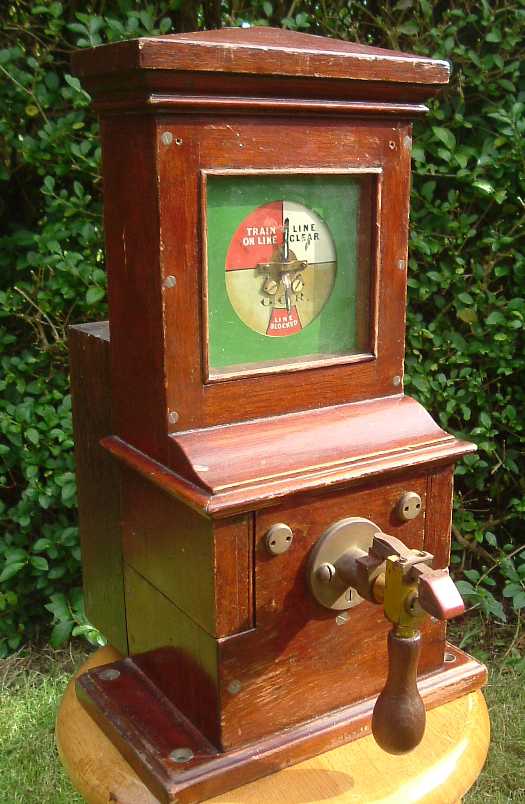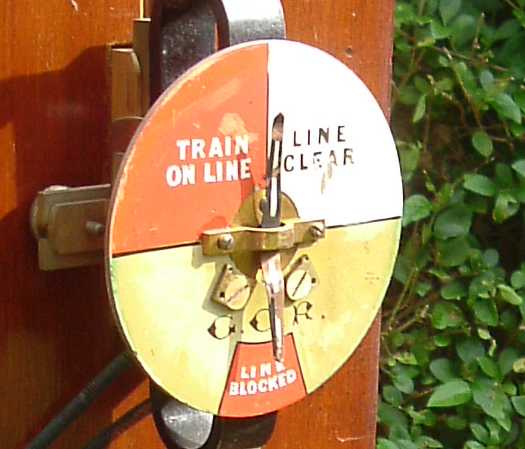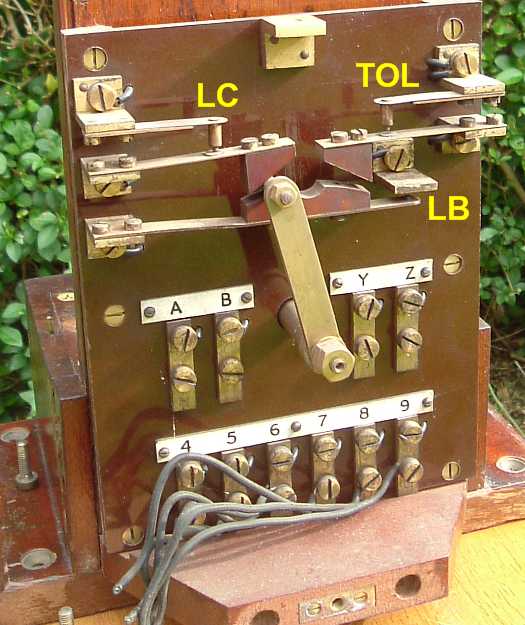circuit 1 + 2 hybrid
One occasionally sees drop handle block instruments with a 'half height' back box. I've seen several photographs of such instruments in-situ on block shelves, but it was a while before I was able to get my hands on an example. Here it is:
 The dial, clearly lettered GCR, is worth a closer look. The lower section of the
dial is usually coloured green, but not in this case.
The dial, clearly lettered GCR, is worth a closer look. The lower section of the
dial is usually coloured green, but not in this case.
 The instrument has a test label dated 15-8-1955. Removing the back box cover shows that the instrument includes features of both
circuits 1 and 2:
The instrument has a test label dated 15-8-1955. Removing the back box cover shows that the instrument includes features of both
circuits 1 and 2:
 Terminals A, B, Y and Z refer to the original commutator contacts and function as
would be expected for circuit 1. Yet the commutator has been extended and
additional contacts have been added, so as to replicate the Tyer rotary commutator
of circuit 2. The photograph shows the commutator in the line clear position, so the
LC contacts are closed, whilst LB and TOL are open. Terminals 4 to 9 refer
to the added circuit 2.
The needle is wired into circuit 2.
This begs the question: why was this instrument so modified? At one level, the
answer is: to use the BZR1 unit to provide block controls with a drop handle
instrument (although one could also ask: why not just fit a Tyer commutator?). The
instrument appears to have been used in this way, going by the wire count on
terminals 4 to 9 (two wires on terminal 6 and one on each of the others).
Yet this does not explain why terminals A, B,Y and Z were retained. They do not appear to have
been used in this case, as there are no remains of wires attached to them, yet they
were obviously made available for use.
I wonder if this was an attempt to reduce the number of independent supplies required
for the BZR1 unit, but that is speculation on my part.
If anyone does know why, I would be interested to know!
Terminals A, B, Y and Z refer to the original commutator contacts and function as
would be expected for circuit 1. Yet the commutator has been extended and
additional contacts have been added, so as to replicate the Tyer rotary commutator
of circuit 2. The photograph shows the commutator in the line clear position, so the
LC contacts are closed, whilst LB and TOL are open. Terminals 4 to 9 refer
to the added circuit 2.
The needle is wired into circuit 2.
This begs the question: why was this instrument so modified? At one level, the
answer is: to use the BZR1 unit to provide block controls with a drop handle
instrument (although one could also ask: why not just fit a Tyer commutator?). The
instrument appears to have been used in this way, going by the wire count on
terminals 4 to 9 (two wires on terminal 6 and one on each of the others).
Yet this does not explain why terminals A, B,Y and Z were retained. They do not appear to have
been used in this case, as there are no remains of wires attached to them, yet they
were obviously made available for use.
I wonder if this was an attempt to reduce the number of independent supplies required
for the BZR1 unit, but that is speculation on my part.
If anyone does know why, I would be interested to know!